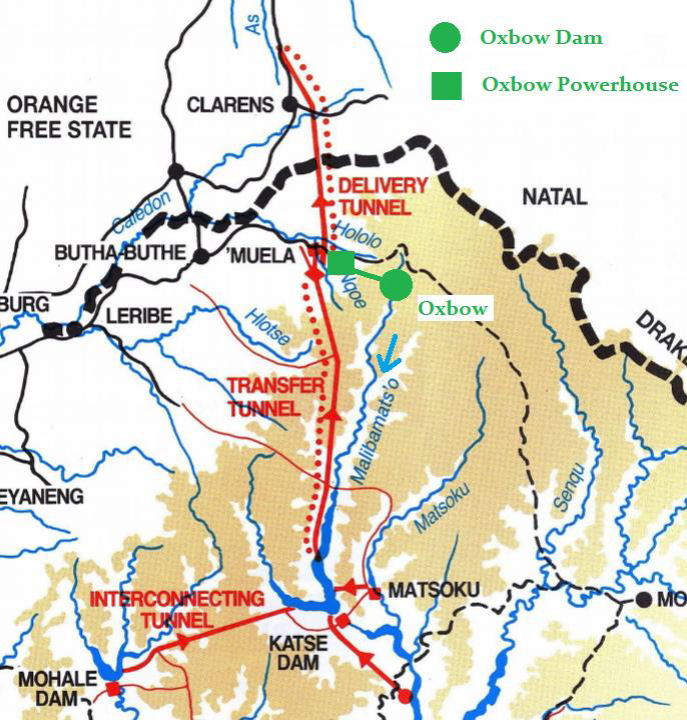Construction of the Polihali Dam and reservoir, water transfer tunnel and the associated access roads, bridges, accommodation, electrical transmission lines and telecommunications infrastructure, will impact on communities in Mokhotlong and adjoining districts. The implementation of Phase II requires the acquisition of land from local communities. Approximately 5,000 hectares of land will be flooded by the Polihali Dam and reservoir in the valleys and tributary catchments of the Senqu and Khubelu Rivers. This will lead to significant impacts on the livelihoods and socio-economic status of the local population as homesteads, cultivation land, trees, grazing land and other natural resources will be inundated and access to resources and facilities impeded. Permanent land acquisition will also be necessary for infrastructure developments such as access roads, power lines, office and residential accommodation, and some land will also be occupied temporarily during the construction period.
The Treaty governing the Lesotho Highlands Water Project and the Phase II Agreement commits both Parties to take “all reasonable measures to ensure that the implementation, operation and maintenance of the project are compatible with the protection and the existing quality of the environment and, in particular, shall pay due regard to the maintenance of the welfare of the persons and communities immediately affected by the Project”. The LHDA is therefore mandated to ensure that the risks associated with resettlement are addressed and that the livelihoods of affected people are restored.
The compensation of affected people is mandated by the Agreement between South Africa and Lesotho governing Phase II. A Compensation Policy for Phase II, which defines the range of losses and specifies compensation and relocation entitlements, has been prepared in consultation with affected communities, local authorities in Mokhotlong District and other stakeholders. The Compensation Policy was approved by the Project authorities in August 2016.
Compensation and resettlement programmes are being implemented to ensure that physically displaced households are properly relocated and re-established, that compensation is paid for the loss of assets and productive capacity, that the livelihoods of affected people are restored, and that other impacts are mitigated in consultation with affected communities and households.
The resettlement programme also includes minimising physical relocation of households to the extent possible – for instance, the Polihali Western Access Road was realigned at numerous locations to avoid impacts on homestead structures. It is currently estimated that 270 households and 21 business enterprises will need to be relocated, mainly due to the impoundment of the Polihali reservoir.
The LHDA has secured the services of two resettlement consultants to assist with the preparation and implementation of the resettlement programmes. The consultants have been working closely with affected communities to:
Resettlement Action Plans (RAPs) have been prepared for the Polihali Western Access Corridor (which encompasses the Polihali Western Access Road and a 132kV transmission line) and for the Transfer Tunnel components on the western (Katse) side. Lima Rural Development-Thaha Joint Venture have prepared a RAP for the Polihali Site Establishment Area (where the major works will occur) and are finalising a RAP for the reservoir area.
The asset registration process has been completed for all current project components, apart from a few areas where verification activities are still underway. Details of the assets and owners (beneficiaries) affected by the advance infrastructure components have been registered in the LHDA’s compensation management system and compensation payments have been initiated (except where assets are under dispute, where there is a change in beneficiary or where the required beneficiary documentation is incomplete). The remaining asset/beneficiary data are being registered for compensation in line with the project’s land acquisition/occupation programme.
Detailed layouts for three relocation sites in the Polihali Site Establishment Area have been prepared in consultation with affected communities and local authorities, and engineering designs are being finalised. Finalisation of three relocation sites is underway for the reservoir area, as well as a potential relocation site in Mokhotlong Town. In addition, floorplans for replacement housing have been prepared by an architect in consultation with affected households.
A number of concept plans have been developed for livelihood restoration that are being discussed with affected households, communities and other stakeholders. The concept plans range from small-scale household level initiatives to larger commercial/investment options to promote development opportunities for the affected communities. These plans have also been incorporated into a Phase II Livelihood Restoration Plan currently under development
Two plans for the removal of affected graves/burial sites have been prepared. The relocation of a burial site in the village of Masalla, affected by the Polihali Western Access Road, was successfully completed at the end of 2020. The relocation of burial sites and individual graves in the Polihali Site Establishment Area is scheduled to commence in the last quarter of 2022, while a third plan for the relocation of graves in the reservoir area is in preparation
A consultant was appointed in November 2020 to prepare a Phase II Social Development Master Plan (SDMP). The aim of this contract is to assess and plan, in close consultation with the Phase II communities, projects for approved social development initiatives, and to prepare a SDMP for implementation that is sustainable and in line with national development strategies and goals.
A consultant was appointed in May 2021 to develop a Master Plan for Feeder Roads and Bridges, with the aim of restoring/improving community movement patterns and access affected by impoundment of the Polihali reservoir. Throughout the various social, resettlement and public health programmes, the LHDA maintains a community liaison function to ensure effective involvement of affected communities in matters that affect their lives and livelihoods.
The implementation of large infrastructure projects like the Lesotho Highlands Water Project (LHWP) can disrupt the lives of people in the project area. It is therefore inevitable that the implementation of Phase II will lead to involuntary resettlement, resulting in physical and economic displacement, with potentially significant impacts on the livelihoods and socio-economic status of the local population.
The Lesotho Highlands Development Authority (LHDA) is mandated by the 1986 Treaty, the LHDA Order and the Phase II Agreement to ensure that the risks associated with involuntary resettlement are addressed and that the livelihoods of affected people are restored. The LHDA seeks not only to restore, but to improve the livelihoods of the communities living in the LHWP II area through initiatives that will be sustainable beyond the construction period. Communities in the project area should become beneficiaries of the development long after the construction.
The mitigation measures include compensation for assets acquired by the project,resettlement of affected households, and livelihood restoration and social development programmes to ensure that the standard of living of the affected households and communities is improved or at least maintained to the pre-project levels.
A number of livelihood restoration initiatives have been designed for implementation in the short term. The interventions include livelihoods awareness programmes, livelihoods options planning, skills testing and accreditation to facilitate employment-based livelihoods. Demonstration projects in the four community councils of Menoaneng, Mokhotlong Urban, Mphokojoane and Seate are being implemented to enhance capacity building initiatives and to illustrate viable projects that could be replicated by individual households and communities. These include village chickens, production of vegetables in tunnels, and bee keeping.
A number of awareness programmes are held throughout the LHWP II areas to help communities make informed decisions about possible livelihood options; such programmes include eco-tourism as a livelihood option and financial literacy education programmes which are led by financial institutions.

In rural communities, most households raise chickens. They are a high source of protein and cash income and play a significant role in sociocultural life. LHDA has embarked on this project because village chickens are already a part of rural life, and such a project can enhance household income earning capacity.

Farmers in many parts of the world are shifting to vegetable production in a protected media, due to challenges brought by climate change, including changing rainfall patterns and harsh weather conditions. In the mountain areas of Lesotho, this situation is worsened by increasing levels of poverty and land degradation.

Plastic covered tunnels are considered appropriate for independent small farmers, as they ensure greater control over growing conditions and lengthen the growing season. The tunnels/shade nets protect produce against hailstorms, high temperatures, pests and diseases, and they contribute to predictable, high-quality yields, which lead to improved incomes
The purpose of the project is to train local households and communities in beekeeping and to support existing beekeepers to process their honey and beeswax. Bees play an important role in the pollination of many flowering crops, thus increasing the yield and contributing to improved food security, as well as generation of income from the sale of honey and related products. Some of the villages in the Phase II area are rich in trees and other plants which make them suitable for bee keeping and honey production.
A Social Development Master Plan (SDMP) is being prepared for Phase II, and involves communities in the identification of needs, priority projects for implementation, roles and responsibilities of stakeholders. It also involves setting of targets, identification of potential sources of finance to assist with wider economic development, and communication of outcomes. Projects within the SDMP could include water and sanitation, rural electrification, public health, agriculture, tourism, social protection, educational enhancement (skills/enterprise training and development) and other human development initiatives. Following approval of the SDMP, the specific projects in the SDMP will be implemented by service providers according to an agreed programme.
Infrastructure projects of the magnitude of Phase II Lesotho Highlands Water Project (LHWP) are informed by extensive research in order to fully understand and mitigate the impact of the project's implementation on the community and the natural environment in the area. Prior to the impoundment and flooding of the area upstream of the Polihali Dam, the LHDA undertook a baseline assessment of the existing ecological, cultural and social environments. These baseline studies included an assessment of the Instream Flow Requirements (IFR) encompassing water quality, flow and geomorphology aspects; the socio-economic conditions; fauna and flora; archaeology and public health. The main objectives of these studies were to:
The study aimed to gain an understanding of livelihoods and quality of life of people in the project area. The study was made up of the following tasks:
The aim of the study was to determine the volume (magnitude), frequency, timing and duration of water flows that need to remain in the downstream river following the construction of the Polihali Dam. This is to afford suitable protection to the river ecosystem and to ensure the long-term and sustainable availability of the ecosystem services on which the downstream communities depend. This study comprised the following tasks:
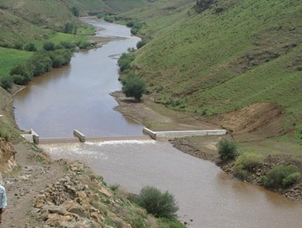
The aim of the study was to establish the baseline conditions for the biological and archaeological aspects of Phase II and to provide appropriate management measures, as well as a monitoring plan. It included undertaking the following tasks:
The Phase II main components include the construction of a concrete-faced rockfill dam at Polihali and a gravity tunnel that will connect Polihali Reservoir to the Katse Reservoir. Phase II also includes the construction and establishment of associated infrastructure, without which the main components (dam and tunnel) could not be built. This includes construction of access roads, bridges, bulk utilities (power, water supplies, wastewater treatment and communications), establishment of quarries and borrow pits, site camps, laydown areas, spoil areas, project housing and site offices.
In terms of the requirements of the Lesotho Environment Act (Act 10 of 2008), the Project must obtain environmental authorisation through completion of an Environmental and Social Impact Assessment (ESIA) for development to proceed. To date, an ESIA including a number of specialist studies and an Environmental Management Plan (EMP) has been completed for the Polihali Reservoir and Associated Infrastructure. A record of decision authorising construction of the two major components (Dam and Tunnel) was issued by Lesotho’s Ministry of Tourism, Environment and Culture on 24 August 2018.
An ESIA including a number of specialist studies and an EMP for the Polihali Western Access Corridor (PWAC) has also been completed. The PWAC is comprised of the Polihali Western Access Road (PWAR), a new, paved road that is 54.3 kilometres long and runs between the A8 near Ha Seshote to the Polihali Reservoir near Tloha-re-Bue (and the Bulk Power Supply and Telecommunications (BPST) Infrastructure. The BPST Infrastructure entails a 35.4 kilometres 132 kV transmission line and substations and telecommunications infrastructure. A record of decision authorising construction of the PWAC components was issued by Lesotho’s Ministry of Tourism, Environment and Culture on 23 March 2018.
In addition to the two ESIAs listed above, a number of EMPs have been prepared for smaller Phase II components, including an EMP for the upgrade of the Polihali North East Access Road (PNEAR), and an EMP for the Diversion Tunnels. Environmental authorisation has been granted. Construction activities relating to the upgrading of the PNEAR is nearing completion. The construction contract for the Diversion Tunnel has been completed. Other EMPs that were submitted to the DoE and approved included stand-alone EMPs for each of the major components and their associated Quarries and Borrow Pits, namely the EMP for the Major Bridges and EMP for Major Bridges Quarries and Borrow Pits; EMP for the Polihali Transfer Tunnel and for the Polihali Transfer Tunnel Quarries and Borrow Pits; and an EMP for the Polihali Dam and Appurtenant Structures and for the Polihali Dam Quarries and Borrow Pits.

In addition to the baseline studies and ESIAs, LHDA intends to implement a number of long-term environmental and social action plans under Phase II including an Integrated Catchment Management Plan, a Cultural Heritage Plan, Resettlement Action Plans, Social Development Plan, Biodiversity Management Plan, Livelihood Restoration Plan, Public Health Action Plan, etc. Implementation of these plans has commenced.
Health is integral to development, and the LHDA is committed to ensuring that the impacts of the Project on the health of the affected population are identified and that measures to mitigate the expected negative impacts and enhance positive public health consequences are implemented. To ensure this, the LHDA has completed a public health baseline study and will develop and implement a public health action plan to address the impacts brought about by the Project.
A Public Health Baseline Study (PHBS) was commissioned in February 2014 and was concluded in June 2016. The study was based on a 20% sample of the households which were enumerated in the Socio-Economic Baseline Study (SEBS). The PHBS was intended to provide comprehensive information on the state of health of the population residing in the project area.
This study aimed to determine the baseline status of social determinants of health and the burden of disease amongst communities in the project area.
The study was made up of the following tasks:

The LHDA appointed a public health team comprising a Public Health Specialist, and Public Health Nurse, and a Data Management Officer to conduct a Health Impact Assessment (HIA) and develop a Public Health Action Plan (PHAP).
This will be done in close collaboration with the MoH and the local health authorities, so that the Ministry continues the ownership of health service delivery and that there is seamless continuation of the health services in the Project area after completion of the construction activities.
The HIA identified several likely impacts and mitigation measures. The major positive impacts include improved access to health services due to the construction of new feeder and major roads; improved community health services and outreach health programme in hard-to-reach areas as a result of construction of roads in the area; generation of jobs for local communities with better access to cash; changes in lifestyle due to access to food and other commodities; improved housing for resettled populations; and universal access to water and sanitation facilities.
With the anticipated influx of approximately 5,000 project workers, job seekers and camp followers during the construction phases of the project, there is a high likelihood of increase in communicable diseases such as coronavirus disease (COVID-19), HIV infections and other sexually transmitted infections. Other impacts include human trafficking, pressure on social amenities, increase in road traffic accidents, violence, alcohol and drug abuse, as well as unintended pregnancies among the youth. Worsening of malnutrition, increase in non-communicable diseases, trauma, psychosocial problems, and drowning in the dam were also ranked among the significant negative project impacts.
The PHAP identifies primary health care as a priority for sustainability of the health programme, and partnership with the Ministry of Health (MOH) as the core for the successful implementation of the PHAP. It aims to ensure that negative health impacts are mitigated and that the positive health impacts are maximized. The PHAP is to be implemented in partnership with the Ministry of Health to ensure sustainability, long after the construction activities have ended. The PHAP has identified priority areas based on the identified project impacts, and mitigation strategies to address these priority areas.
Phase II of the Lesotho Highlands Water Project includes the construction of a dam at Polihali, the Polihali to Katse water transfer tunnel, and a significant investment into ancillary advance infrastructure that needs to be put in place before the dam and tunnel can be built. This includes power lines and telecommunications links; roads; major bridges, offices, workshops and residential accommodation for people working on site. Much of this infrastructure will benefit the communities in the vicinity of the project in the long term.
The electrical infrastructure required for the Phase II development includes the construction of new substations, upgrading of existing Lesotho Electricity Company (LEC) substations, the construction of new power lines, and the diversion of some of the existing distribution network.
A new power substation will be constructed at Polihali Dam, and another will be built adjacent to the existing Matsoku diversion substation. Substations at the Katse tower intake and Ha Lejone will be upgraded. The protection and control systems of the Maputsoe, Pitseng and Matsoku diversion substations will be upgraded. Furthermore, all substations will be equipped for remote control from the LEC national control centre, located at Mabote substation near Maseru.
The electrical infrastructure also includes the construction of a 132kV transmission line between Matsoku substation and the new substation at Polihali. The existing 20km transmission line from Ha Lejone to Matsoku will also be upgraded from 66kV to 132kV. A 33kV power line of 2.2km has been constructed from Tlokoeng to Polihali to supply early power for the advance infrastructure contracts prior to the completion of the main power from Matsoku.
After the construction of Polihali Dam and Polihali transfer tunnel, the infrastructure built in Phase II and integrated into the LEC network will improve the supply to local communities.
The project will establish a communications network backbone which will be integrated with the existing LEC network through fibre optic and microwave radio links. A Network Management system (NMS) will also be established. Cyber security equipment, and IP based Video Conference System and other voice communication equipment will be installed to improve communication at the project area.
Construction of roads is one of the major components of the advance infrastructure under Phase II. A new road that leads to the dam site will be constructed while two existing roads will be upgraded.
he existing Polihali Northeast Access Road (PNEAR), a 16-kilometre long gravel road which starts in the town of Mapholaneng and runs towards the Polihali Dam site, will be upgraded to a Class A surfaced road. The road will provide access to the dam site for construction vehicles and will improve ease of movement for communities in the surrounding areas. The works include earthworks, layerworks, a roundabout that links the PNEAR and the A1, double seal surfacing, sidewalks, drainage systems and other appurtenant works.
The Polihali Western Access Road (PWAR) is a new, 54.3-kilometre paved road linking the A8 in the vicinity of Ha Seshote in the west to Polihali in the east. It will join the PNEAR at Polihali. The works include earthworks, layerworks, three new bridges across Matsoku, Semenanyane and Makhoaba rivers, asphalt surfacing, drainage systems and appurtenant works.
The Northern Access Road (NAR) will be repaired, including existing bridges and resealed using asphalt with minor safety upgrades. The section that will be rehabilitated stretches for 98 kilometres from the Pitseng village up to Katse village. It provides access to the Katse Dam basin, and will tie into the PWAR at Ha Seshote to provide a further link to the Polihali basin.
The Polihali reservoir will inundate a large area which includes existing roads and bridges. As a result of the impounding of the Polihali reservoir, a number of existing roads and tracks will become unusable and will need to be replaced. The restoration of roads requires construction of a number of new road sections leading to new bridge structures which are required to cross the reservoir. Three major bridges will be built along the Maseru to Mokhotlong A1 road. One bridge will be at Mabunyane River and another at Khubelu River. The biggest bridge will be at the Senqu River and will be approximately 880 metres long and 110 meters high.

Permanent housing will form a legacy estate for the project, and as such is designed to the principles of energy efficiency and sustainability while at the same time fitting into the rural landscape of the site. The houses will be used by on-site personnel from the LHDA, dam and tunnel consultants, and others including relevant Government of Lesotho (GoL) officials. In the post-construction phase, the houses will be used by the LHDA Operations team and related GoL departments.

The operations centre will be a multifaceted building comprising an office building, exhibition hall, conference facilities and Visitors Information Centre. This building is located strategically on the water`s edge so that occupants are always presented with dam views. It is influenced by the terrain and blends into the shape and profile of the land. The building will be used by LHDA and dam consultants during the construction phase, and LHDA Polihali Operations will take it over post-construction.
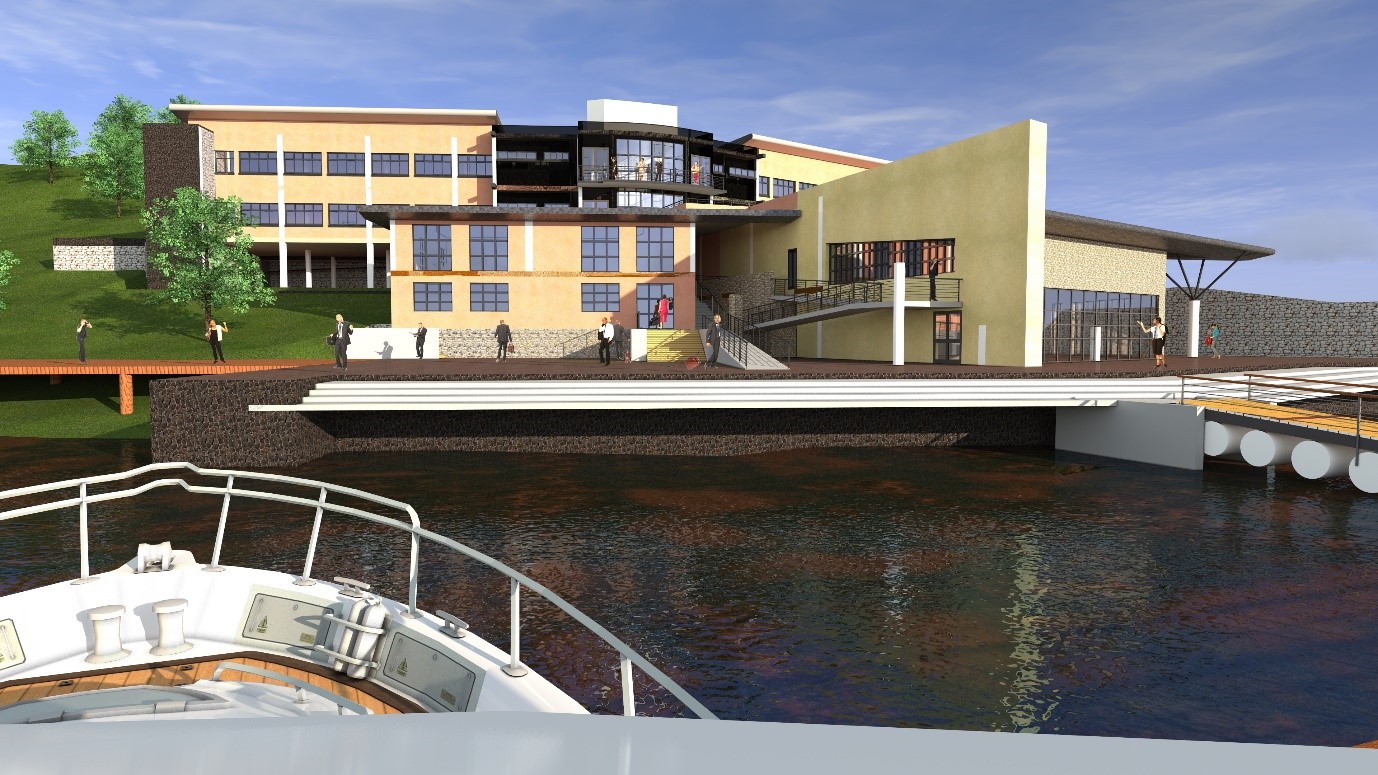
This is a retail centre which will focus on the provision of convenience shopping space for the day-to-day needs of consumers at Polihali village and the immediate neighbouring villages. It will be anchored by a small supermarket, will include speciality shops, and has space to accommodate a small clinic and a police post.
Like the other buildings in the development, the commercial centre incorporates a number of sustainable initiatives into the design, such as orientation and materials. As a response to the cold climate and to meet optimal energy efficiency requirements, the building has been designed to minimise excessive heat loss in winter and heat gains in summer.

The building is designed atop a strategic point in the Polihali village, allowing it to overlook the future dam. After construction, the Polihali Dam will become a primary tourism attraction in the Lesotho Highlands Project area, hence the prominence accorded to the location of the lodge. The building design and layout is influenced by the local terrain and site orientation. The aim is to create a welcoming atmosphere to highlight the natural beauty and wonders of Polihali.
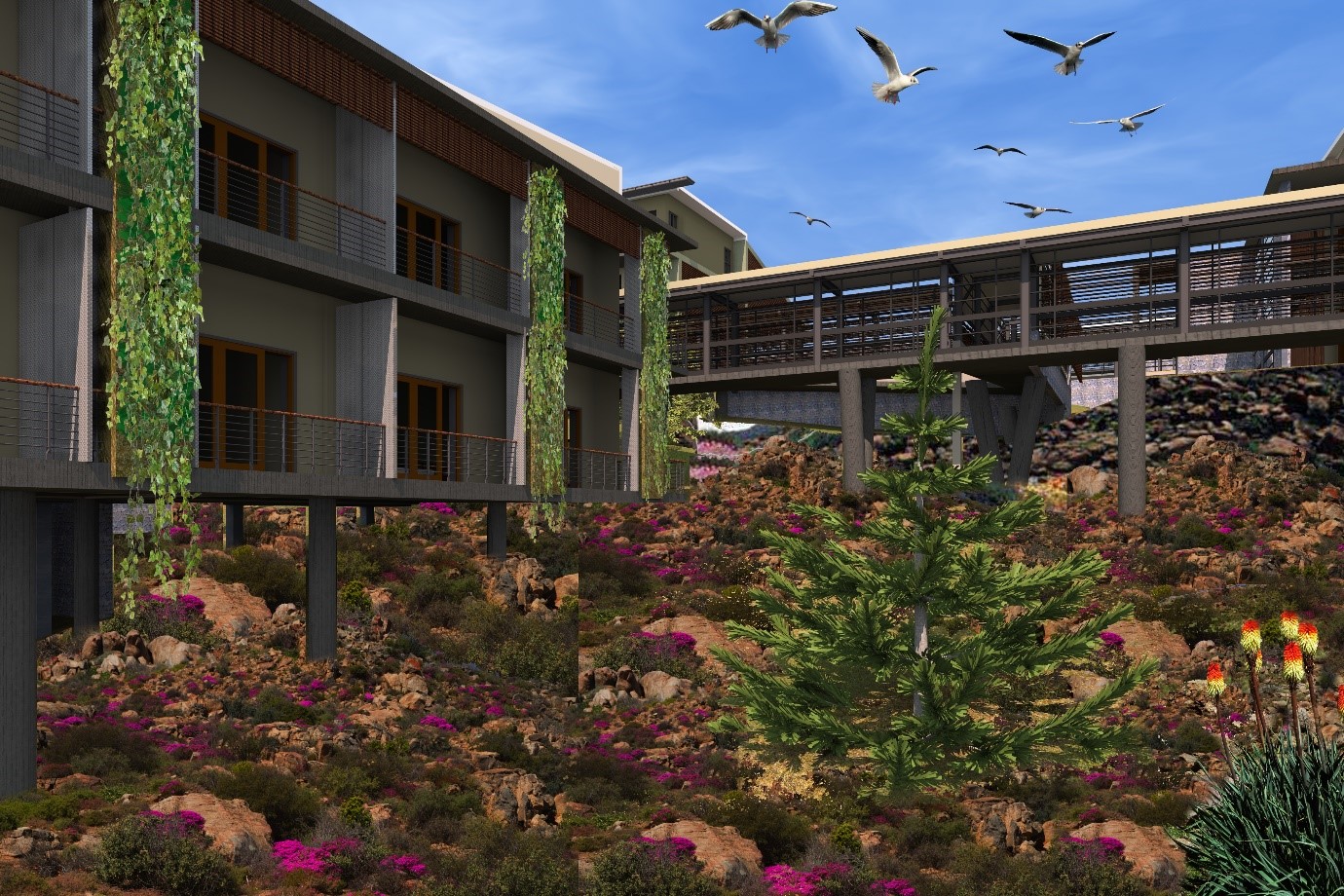
Building developments in the Phase II project also entail the construction of single quarter housing for LHDA operations staff at the Katse village and the upgrading of Katse Lodge. This is because the water transfer component of Phase II will increase the potential for tourism and more operations staff will be based at Katse due to the increased workload.
Katse Lodge is being upgraded to increase the floor area in some parts and to include staff change rooms, laundry area and workshop for improved convenience. The physical upgrades also include finishes, fittings, furniture and aesthetics with the aim of attaining a 4-Star Rating.
Larger windows and covered terraces will be provided to maximise exposure to the dam views. A multi-purpose fitness centre and conference facilities will also be built.
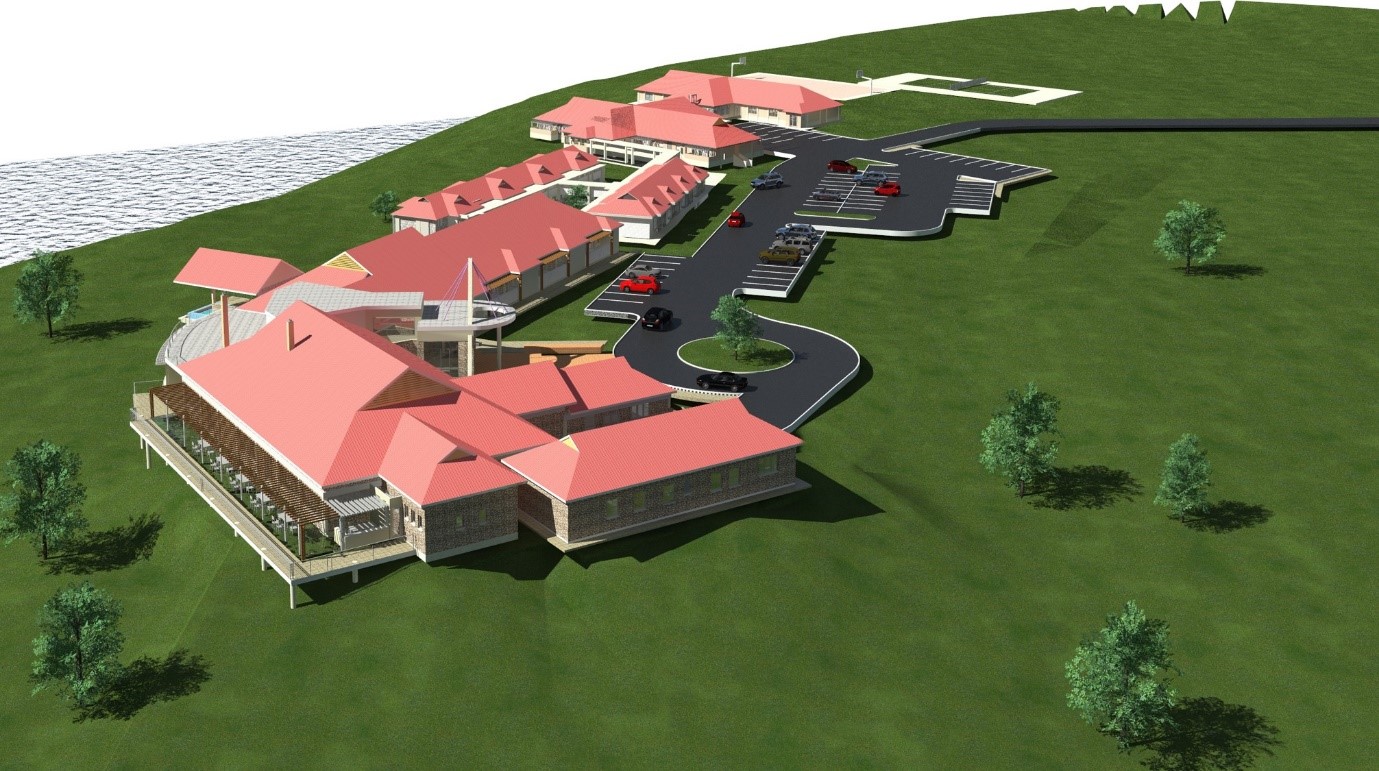
Like the majestic Mohale Dam, which was built during Phase I, both the Polihali Dam and the saddle dam will be concrete faced rockfill dams (CFRD). Mohale is a large dam. Standing at 145 metres high and with capacity to hold 950 million cubic metres of water at its full supply level, it was the largest of its kind in Africa at the time it was built.
Polihali Dam will be bigger.
The embankment will stand 166 metres high, have a crest length of 921 metres and a crest width of 9 metres. At its base, the embankment will be approximately 490 metres wide. Over 14 million cubic metres of rock, which will be quarried locally within the dam basin, will be compacted to form the embankment. The dam will create a reservoir on the Senqu and Khubelu rivers with a surface area of 5,053 hectares and a full supply storage capacity of 2,325 million cubic metres. The Polihali dam infrastructure includes a spillway, a compensation outlet structure and a small hydropower station.
The saddle dam will be 43 metres high and will have a crest length of 603 metres and a crest width of 9 metres. Its function is to raise a low point on the reservoir margin to prevent water from by-passing the Polihali Dam.
Just as the water from the Mohale reservoir flows through the interconnecting Mohale Transfer Tunnel to the reservoir at Katse, so will water from the Polihali reservoir flow through the Polihali Transfer Tunnel on its way to Katse, increasing the supply of water to the Katse reservoir and the amount of water available for hydropower generation at the ‘Muela Hydropower station.
The current supply rate of water from Lesotho to Gauteng of 780 million cubic metres per annum will be increased incrementally to reach 1270 million metres per annum, as agreed by the two Governments. Polihali Dam is expected to contribute about 490 million cubic metres of water per annum to the system for delivery to RSA.
Work on the dam design commenced in 2017 and tender design was completed during 2020. Construction is expected to start in 2022, with completion and commissioning expected in 2028.
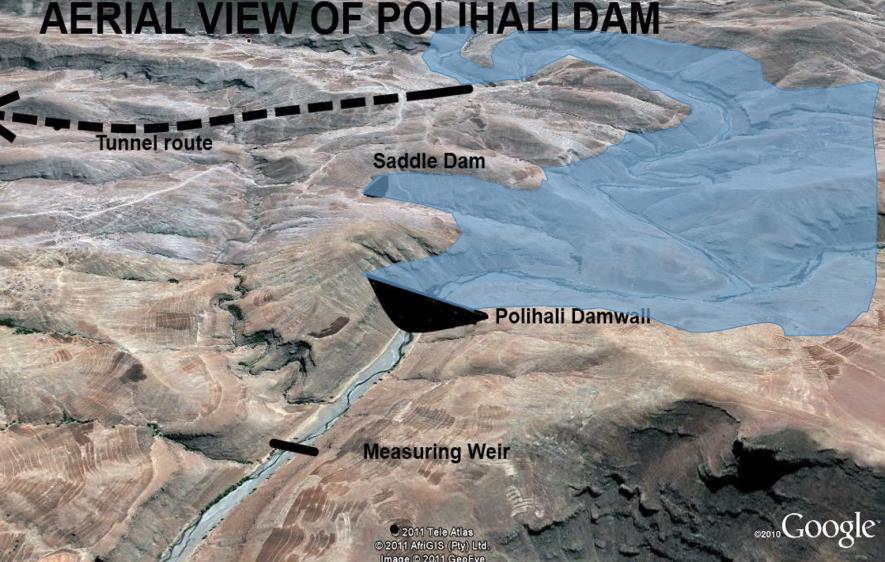
The main purpose of the Lesotho Highlands Water Project is to harness the water resources of the highlands of Lesotho through the construction of a series of dams and tunnels to deliver specified quantities of water to South Africa and to utilise the water delivery system to generate hydro-electric power in the Kingdom of Lesotho.
The water transfer component of Phase II comprises a Concrete-Faced Rockfill Dam (CFRD) and saddle dam at Polihali, downstream of the confluence of the Khubelu and Senqu (Orange) Rivers, and a gravity tunnel that will connect the reservoir at Polihali to the Katse reservoir.
In addition, river diversion tunnels will be built prior to the construction of the Polihali Dam.
Just as water from Phase I’s Mohale reservoir flows through the interconnecting Mohale Tunnel to the reservoir at Katse, so will water from the Polihali reservoir flow by gravity through the Polihali Transfer Tunnel on its way to Katse.
The envisaged transfer tunnel will be approximately 38 kilometres long with a nominal bore of five metres. Both tunnel boring and drill and blast methods will be used to excavate the tunnel.
The Polihali Transfer Tunnel works also include the intake works and gate shaft at the Polihali reservoir; outlet works and gate shaft at the existing Katse reservoir, with underwater connection to the lake; access adits to the waterway and associated construction infrastructure. Training LHDA staff for the purposes of operating and maintaining the tunnel is part of the skills and technology transfer element of the tunnel project.
Work on the tunnel design commenced in mid-January 2018 and was completed during 2019. The construction contract was tendered during 2021 and construction is expected to commence during 2022.
The diversion tunnels for the Polihali Dam were designed and excavated in advance of the construction of the Phase II main works – the Polihali Dam and Polihali Transfer Tunnel - as part of Phase II’s advance works.
Diversion tunnels divert water away from the natural riverbed to create a dry foundation and work area needed for the construction of the dam. Their construction usually goes along with the building of the cofferdam, one upstream and one downstream of the proposed dam, which together allow the river flow to bypass the dam foundation area.
In the case of the Polihali Dam, two diversion tunnels have been constructed to divert the waters of the Senqu River. Building two tunnels increases the capacity to carry floods and will provide flexibility to work in one tunnel while the river flows in the other one.
The tunnels, one 7 metres in diameter and almost a kilometre in length, and the second, 9 metres in diameter and also almost a kilometre long, run parallel to each other from the intake point to the outlet downstream of the dam. The tunnels were excavated by drill and blast method, and supported by rockbolts and shotcrete as required.
Construction of these tunnels was completed in November 2021, in advance of the appointment of the Polihali Dam construction contractor which is planned for 2022.
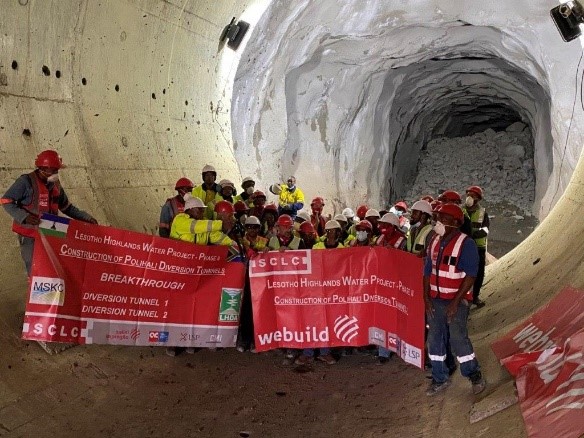
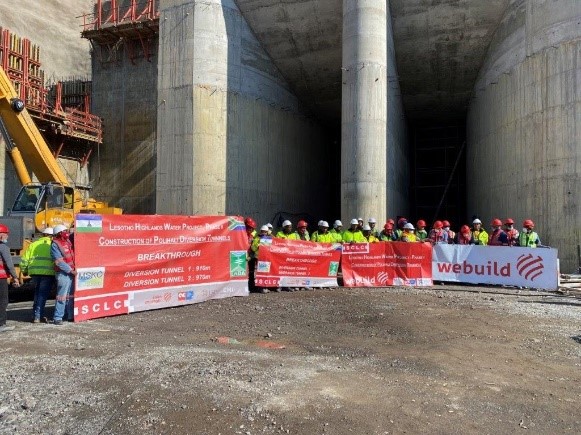
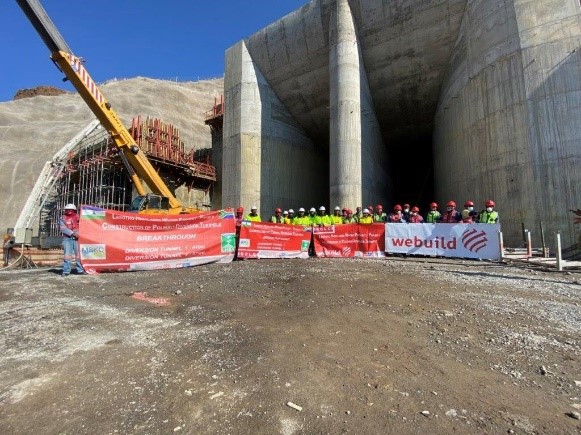
The Lesotho Highlands Water Project (LHWP) is a multi-billion Maloti/Rand bi-national project between the Governments of the Kingdom of Lesotho and the Republic of South Africa, which was established by the Treaty of 1986 and the 2011 Agreement signed between the governments of the Kingdom of Lesotho and the Republic of South Africa. The Project harnesses the water resources of the Lesotho highlands through the construction of a series of dams and tunnels for the mutual benefit of Lesotho and South Africa, supplying water to the Gauteng region of South Africa and hydropower to Lesotho.
The first phase (Phase I) of the multi-phased project was completed in 2004 and the second phase (Phase II) is currently underway.
Article 8 of the Phase II Agreement determined that the hydropower generation component of Phase II would comprise a pumped storage scheme utilising the existing Katse Reservoir as the lower reservoir and a new upper reservoir in the Kobong valley, or any other scheme to generate hydropower. This determination was made following the initial hydropower feasibility studies which were conducted in 2008 and 2011.
The Agreement further stipulated that the implementation of the Kobong pumped storage scheme was subject to the outcome of further detailed feasibility studies. These further studies would include:
At the same time, these studies were to explore alternative viable hydropower generation schemes that will increase the electricity generation capacity in Lesotho to meet the country’s electricity requirements.
Following an open tender process, in late 2016 the LHDA appointed a Joint Venture comprising EDF (France), GIBB (RSA) and Multiconsult (UK) to undertake the feasibility studies. Having completed the feasibility studies, the pumped storage scheme option has been deferred due to the prevailing unfavourable economic conditions, and conventional hydropower has been recommended as the more feasible option to meet Lesotho’s energy needs. To this end, the decision was taken to develop a hydropower scheme at Oxbow. Procurement of the engineering consultant for this scheme is planned for 2022.
